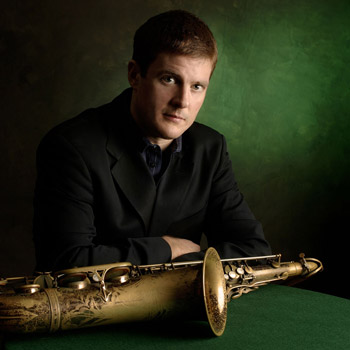Audio clip: Adobe Flash Player (version 9 or above) is required to play this audio clip. Download the latest version here. You also need to have JavaScript enabled in your browser.
(The clip starts at the first solo chorus)
Download the transcription: Bb
This a really amazing solo that will probably keep you busy for a long time if, like me, you decide to study it in depth. It is 17 choruses long and you can find it in David Hazeltine’s CD Autumn in Manhattan. This C7 blues solo is played at a very fast tempo. My recommendation is that you start playing it at about half the original speed and then gradually increase it as you begin to technically master the solo.
The head of the tune is basically built on a simple pentatonic motif – G Bb C D Bb C – that you will find, slightly modified, in the beginning of the solo and in several parts of different choruses. This repeated use of the motif gives strong coherence to the solo.
Eric masterfully keeps things interesting throughout the whole solo, frequently mixing some traditional blues licks with hipper, more modern-sounding ones. He often uses simple but effective pentatonic ideas (see, for example, bars 1 through 6 of Chorus 1 and the first 6 bars of Chorus 3, or, for slightly more complex pentatonic ideas, bars 5 and 6 of Chorus 5). There are also frequent major pentatonic ideas, like the phrase in bars 7-8 of Chorus 1, which you find again, slightly modified, for example, in the first two measures of bar 1 of Chorus 4, in bar 11 of Chorus 6, in bars 2-3 of Chorus 13 and in bar 8 of Chorus 17. There are also some nice minor 6 ideas, the one in measure 11 of Chorus 2 being my favorite. Another improvisational device is a great pentatonic superimposition that Eric makes in Chorus 8, 9-12, where he superimposes an Ebminor lick over the basic chord structure.
Another interesting approach is the use of the tritone triad to approach the IV chord. For example, in the first two measures of Bar 3 of Chorus 2, Eric clearly outlines the F# major triad and then chromatically approaches the 5th of F7 in the next bar. I also find the mix of pentatonic and diminished ideas particularly effective in some parts of this solo. For example, in the beginning of Chorus 11, Eric starts with a simple three-note C pentatonic idea, slides into a 4-note F#m pentatonic cell, followed by a 4-note D diminished (half-whole) note sequence in the beginning of bar 2, then back to a C minor pentatonic lick and finally into a 4-note F#minor pentatonic phrase in the last two measures of bar 3. At the fast tempo at which he plays this tune, it sounds awesome! Another interesting approach is the use of ascending chromatic keys in the first four bars of Chorus 15, where, every two measures, Eric plays a different triad – C, C#, D, Eb, E, Eb, D and C#. This nicely builds tension that is then released when he lands on the IV chord in bar 5.
There is so much more in this solo and you’ll probably be able to see/hear this that I haven’t even figured out yet. There is also a small number of bars (9-12 of Chorus 16 and bars 1 and 5 of Chorus 17) where I just couldn’t figure out how to notate what Eric does, so I decided to leave those blank. Listen yourself and see if you can figure it out!
